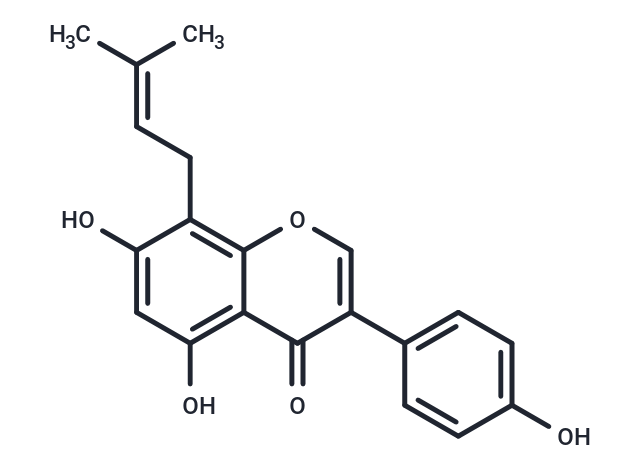Shopping Cart
- Remove All
 Your shopping cart is currently empty
Your shopping cart is currently empty

Lupiwighteone has anti-angiogenesis potential, it also has anticancer and cancer preventive effects on SH-SY5Y cells.

| Pack Size | Price | Availability | Quantity |
|---|---|---|---|
| 1 mg | $159 | In Stock | |
| 5 mg | $397 | In Stock | |
| 10 mg | $589 | In Stock | |
| 25 mg | $945 | In Stock | |
| 50 mg | $1,280 | In Stock | |
| 1 mL x 10 mM (in DMSO) | $570 | In Stock |
| Description | Lupiwighteone has anti-angiogenesis potential, it also has anticancer and cancer preventive effects on SH-SY5Y cells. |
| In vitro | This study aimed to examine the antitumor activity of Lupiwighteone, explore its antitumor mechanism in a human prostate carcinoma cell line (DU-145), and evaluate its antiangiogenetic activity in the human umbilical vein endothelial cell line (HUVEC). The results showed that Lupiwighteone could inhibit the growth of DU-145 and HUVEC cells in a concentration-dependent and time-dependent manner by a 3-(4,5-dimethylthiazol-2-yl)-2,5-diphenyl tetrazolium bromide assay. Flow cytometry analysis indicated that Lupiwighteone could induce cell cycle arrest, cells apoptosis, mitochondrial membrane potential loss, and an increase in intracellular reactive oxygen species of DU-145 cells. Upregulation of Bax, cytochrome c, caspase-3, and PARP-1 protein expressions and downregulation of Bcl-2, procaspase-9, and p-Akt protein expressions were observed by western blot after the treatment of Lupiwighteone. Furthermore, the effects of Lupiwighteone on the cellular behavior of HUVECs were also investigated. |
| Molecular Weight | 338.35 |
| Formula | C20H18O5 |
| Cas No. | 104691-86-3 |
| Smiles | CC(C)=CCc1c(O)cc(O)c2c1occ(-c1ccc(O)cc1)c2=O |
| Relative Density. | 1.351 g/cm3 (Predicted) |
| Storage | Powder: -20°C for 3 years | In solvent: -80°C for 1 year | Shipping with blue ice. | |||||||||||||||||||||||||||||||||||
| Solubility Information | DMSO: 60 mg/ml (177.33 mM) | |||||||||||||||||||||||||||||||||||
Solution Preparation Table | ||||||||||||||||||||||||||||||||||||
DMSO
| ||||||||||||||||||||||||||||||||||||

Copyright © 2015-2024 TargetMol Chemicals Inc. All Rights Reserved.